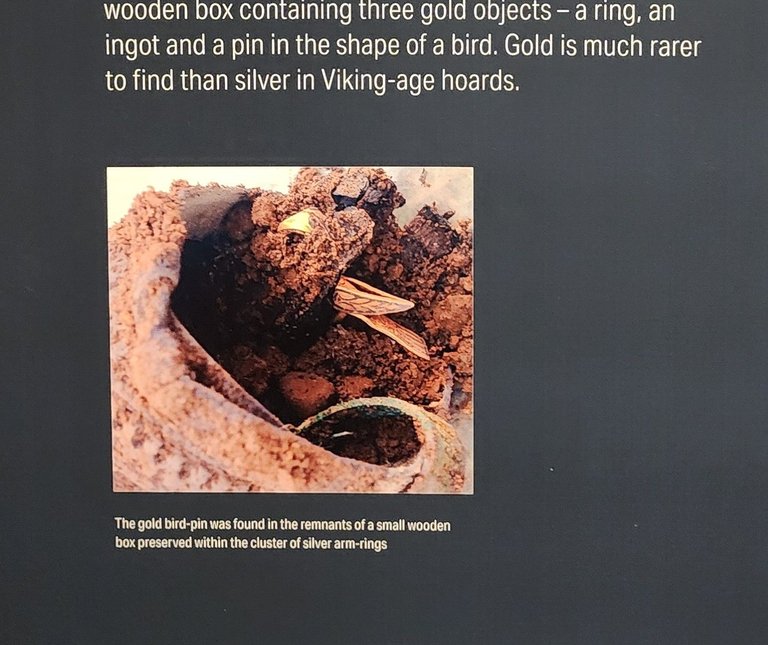
That's one of my most favoured Viking quotes because it speaks about preparation; over a a thousand years ago when the Vikings were one of the most progressive cultures of the world preparation was a key factor and I believe it is still. It's not just about battle, it's preparing for everything from ship-building at the right time to preparing fields, trade agreements and alliances and everything else it took for a person to eke out a living and to eventually thrive back then, which the Vikings certainly did. I'm a prepared guy, so this quote resonates with me and has done for most of my life; I've benefitted from it greatly.
Some while ago I decided to take a look at a visiting exhibition at the South Australian Museum called the Galloway Hoard from Scotland, a collection of Viking gold and silver (and vary rare organic materials) found in Balmaghie, Kirkcudbrightshire and which dates back to (circa) AD 900. History fascinates me and I find the past a more interesting place than modern times so I was eager to see the hoard for myself.
The common-held belief about Vikings is that they were a brutal and warlike people who conducted devastating raids and began wars in aid of rape and plunder of all sorts, and they were, however that wasn't the full story.
Vikings were farmers, explorers, traders, colonists, sailors, craftsmen and women, family men and women, expert negotiators (not just with sword and axe), ingenious inventors, creative thinkers, deeply spiritual, and so much more. I'm drawn to their culture and beliefs, their methods also, so a chance to get closer to them through the Galloway Hoard was an opportunity I'd never pass up.
In this post I'll add a few images of the hoard, all taken by me, and write a line or two here and there. What I'll not do is do the incredible nature of the items and stories behind them any justice at all; that's something one needs to see and discover for themselves and as for the stories, surmising's and meanings...well, people dedicate their entire lives to studies around the Viking culture and the people so if you're keen get to it.
The Viking cross in the main image above shows quite clearly the skill of Viking craftspeople with its delicate gold inlays used to emphasise certain features and careful cleaning and study also shows Niello (black silver sulphide paste) was inlaid into the carved patterns for additional contrast against the silver. Interestingly, it was discovered with the incredibly fine spiral chain still attached (this is rare) which suggests it may have been recently worn before the heard was buried.
Vikings, ever able to adapt, were often found to renounce their own gods to convert to the teachings of Christ and this piece clearly demonstrates that. This piece, decorated in the late Anglo-Saxon style and depicting symbols of the four evangelists, Saint Matthew, Saint John, Saint Luke and Saint Mark is an indication of a people seeking to fit in - were they all about conquest and plunder it's unlikely they'd do such things considering their military ingenuity and tactics and prowess and ferocity in battle often far-outmatched their opponents'. Clearly they wanted to fit in an assimilating into the cultures they found themselves is was one way they did so. Of course, often their conversion was diversionary and calculated and they secretly held to the old ways and old gods - I don't blame them.
This single piece has brought much puzzlement and its secrets are not fully revealed, but it surely displays the maker's skills.
Below are a selection of arm-rings; I'm sorry but they were difficult to photograph properly due to reflecting lights off the glass cases. Some are complete but many were hacked so I wonder, damaged in battle, or hacked off after battle/death/capture and hacked to distribute the wealth, or hacked by a plough at some later date?
Interestingly, those that were complete were very accurately weighed to standardised weights such as 53.2 grams which exactly two ounces and 79.8 grams which is three ounces; obviously this was by design not accident.
I didn't get a good enough image of it but one has the name of Eggbreht (Egbert) inscribed on it, (common old-English name) however it was inscribed in Anglo-Saxon runes and not Scandinavian. It is thought the name was inscribed by locals and could have been inscribed on it at a later date than at its making.
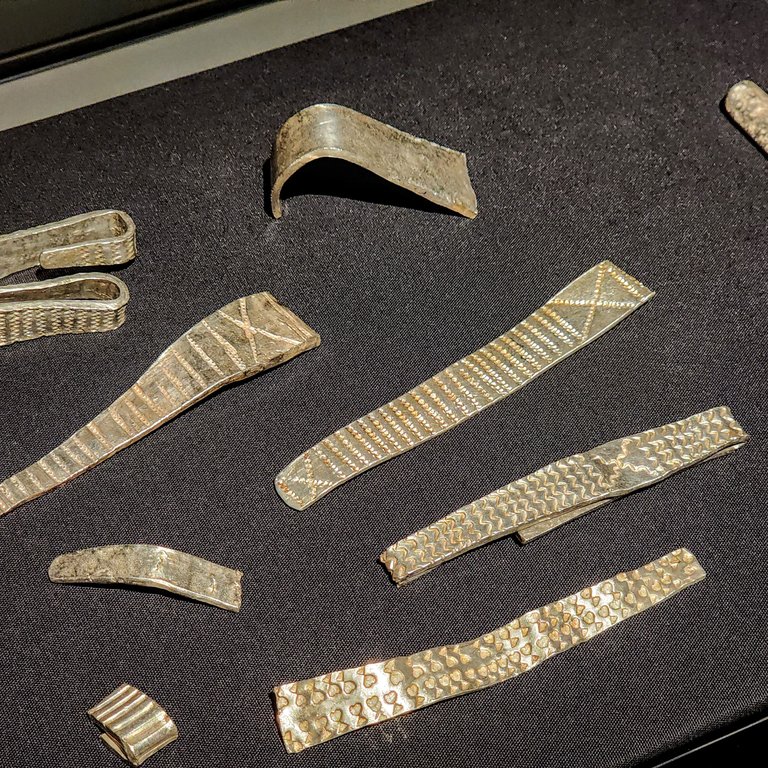
Here's a cluster of four arm-rings and quite interestingly they were found "bound together" by a smaller arm-ring (on the right). They are very intricate as expected based on what we know of Viking artisans. Why were they bound together? Were they taken from four different defeated foes and bound together for ease of transport or safekeeping? These were found with a small wooden box nestled inside them which contained three gold objects being a ring, ingot and pin in the shape of a bird. Incredibly, the wood of the box was still present which is one of the things that makes this hoard so rare, its carbon-datable.
I couldn't get a decent photo of the gold bird-pin but they had an image on an information board and I snapped it. If you want to see it, ask me in the comments and I'll upload it. Unfortunately the exhibition was lit quite dimly (for obvious reasons) and no flash photography was permitted so the images I have are quite poor really.
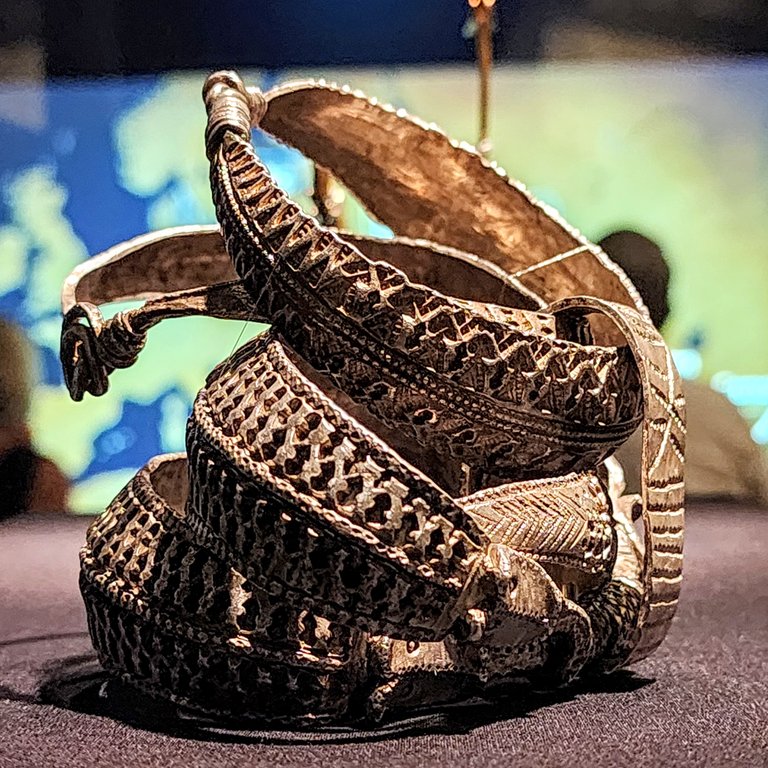

Researchers consider the lidded vessel as the heart of the hoard and it draw a lot of excitement. Only the third such to be found in the UK this one was not filled with the usual silver bullion, that was buried outside the vessel. It wasn't empty though and what was inside is unique to any Viking hoard ever found; it's also the only vessel found with its lid intact.
Incredibly, it was found with two layers of textile wrapped around it which is in remarkable condition - see below lower left (an image I took of an image as they don't let the actual sample out of the laboratory.) They feel this vessel itself is from Central-Asia which again suggests how far and wide Vikings roamed and their keenness to trade outside of their own culture.
They have the real vessel locked away (the image above is a model made after 3D x-ray scanning which also allowed researchers to see inside the vessel and scan the exact items within. The outer layer of textile was wool and the second layer was linen. Torn away from items of clothing to warp the 10cm x 10cm vessel or purpose-made for it?
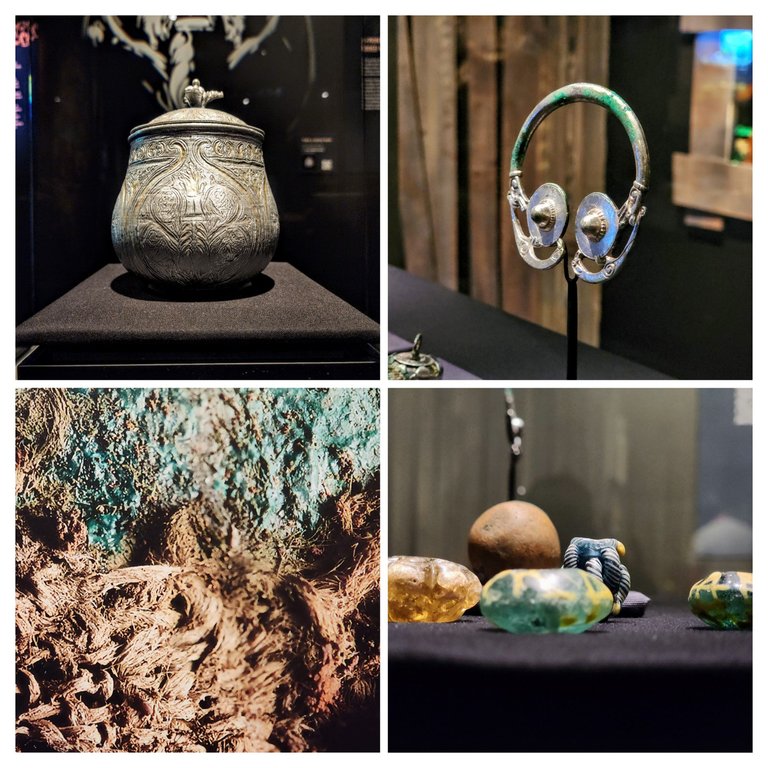
Inside the vessel were many items, twenty-plus, including gold objects, glass, rock crystal and minerals and metalwork of an Anglo-Saxon origin. Some of the items were wrapped in leather, silk or linen or connected by braids of silk. It suggests that this was a highly-valued collection of items and could have been personally owned, important community or religious items...or maybe some well-organised Viking warrior held them as plunder.
I'm mindful of this becoming a really long post so I'll start to wrap up however want to show a few additional items first.
In the collage below are a pair of quatrefoil broaches (cross-shaped). This shape is unique to the Galloway Hoard, never found before, which is interesting in itself. The iconography shows two of the five senses being sight and hearing which could indicate they were commissioned as a pair and those two senses were preferred or as part of a five-broach set and the other three were loas somewhere. Who knows?
Upper left is a disc broach and there's many signs that it's been repaired over the years to ensure its continued use. These are usually found in pairs however it was alone so I suppose it could have been plundered or taken from a foe, or maybe its owner just lost the other? Either way, it was clearly important enough to have repaired so meant something to someone.
Lower left is a cool item, gold beast-head mounts with blue glass eyes. These were found strung together by silk cord to a four-point mount (partially seen in my image) and the beast-heads were the end points, sort of like those little plastic things at the ends of shoe laces. It's thought they could have been used to retain a woman's head veil/covering or possibly on a girdle (belt) as an adornment. I love this one as it shows different aspect of Viking life and attention to detail. Of course, with gold being so valuable, the owner would have been of high standing and wealthy.
The two items to the lower right are decorative bands or straps which are hinged for articulation so probably designed to be worn in places where movement was expected like bracelets or as decorative clothing adornments. They seem quite delicate so perhaps they were made for a child? Inside the vessel some small detached hooks were found indicating that these straps were possibly attached to leather or fabric. Again, in line with the uniqueness of the Galloway Hoard these are not at all common in Anglo-Saxon metalwork so raise new questions.
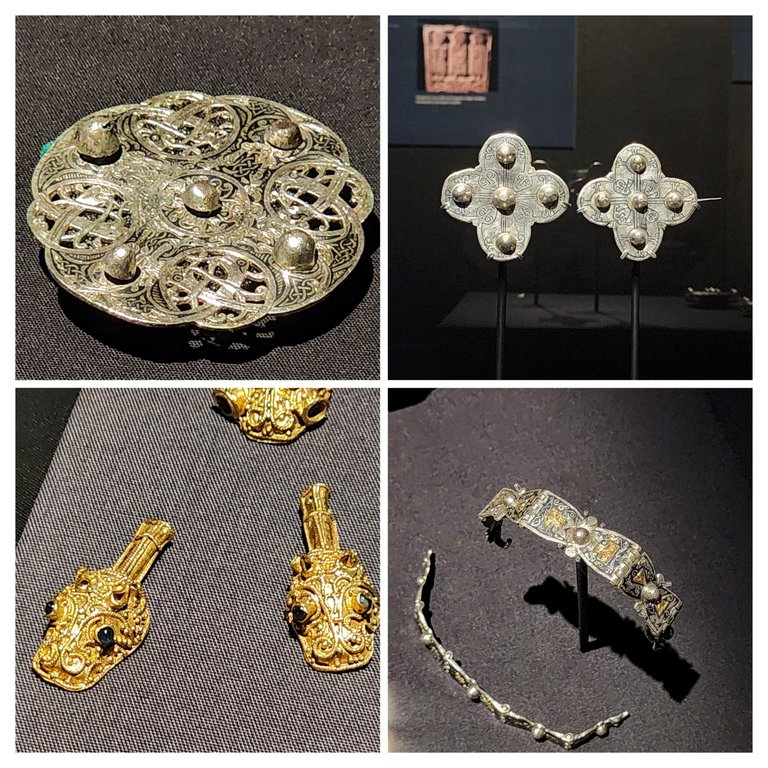
I paid $50 to enter the exhibition (two adults) which I thought was fair. It takes about 45-60 minutes to move around it, observe and read although I was there for 90 minutes due to watching a couple videos twice and reading and re-reading some of the information.
I found it to be very interesting, my love history wouldn't allow otherwise, and I think many would even without a shared passion for history.
We live in a modern society where information is so easily gained, we're so advanced, and yet people focus on things that don't broaden their experience and knowledge such as video games and what a celebrity in another country might be eating for breakfast or wearing to an event. I believe there's more to be discovered and explored than that, and also believe people's care-factor for anything but the very superficial is rising which is to their, and current and future societies' detriment.
We're all different though, I understand that, and what is important to one may not even rate to another; I just can't help but wonder what people in a thousand years might reveal about our current society though. Having made that point...well, I doubt humanity will be around in a thousand years so it's a moot point.
I find such value in looking into the past and seeking answers although often find more questions too. What I know for certain is that so many answers to current issues and challenges can be found in the past as those who came before us have made the same mistakes we are making today - subsequent generations seem incapable of learning - and should we make the effort to uncover some of those answers we may, just may have a slight chance of creating a future rather than destroying it.
Design and create your ideal life, tomorrow isn't promised - galenkp
[Original and AI free]
Image(s) in this post are my own
